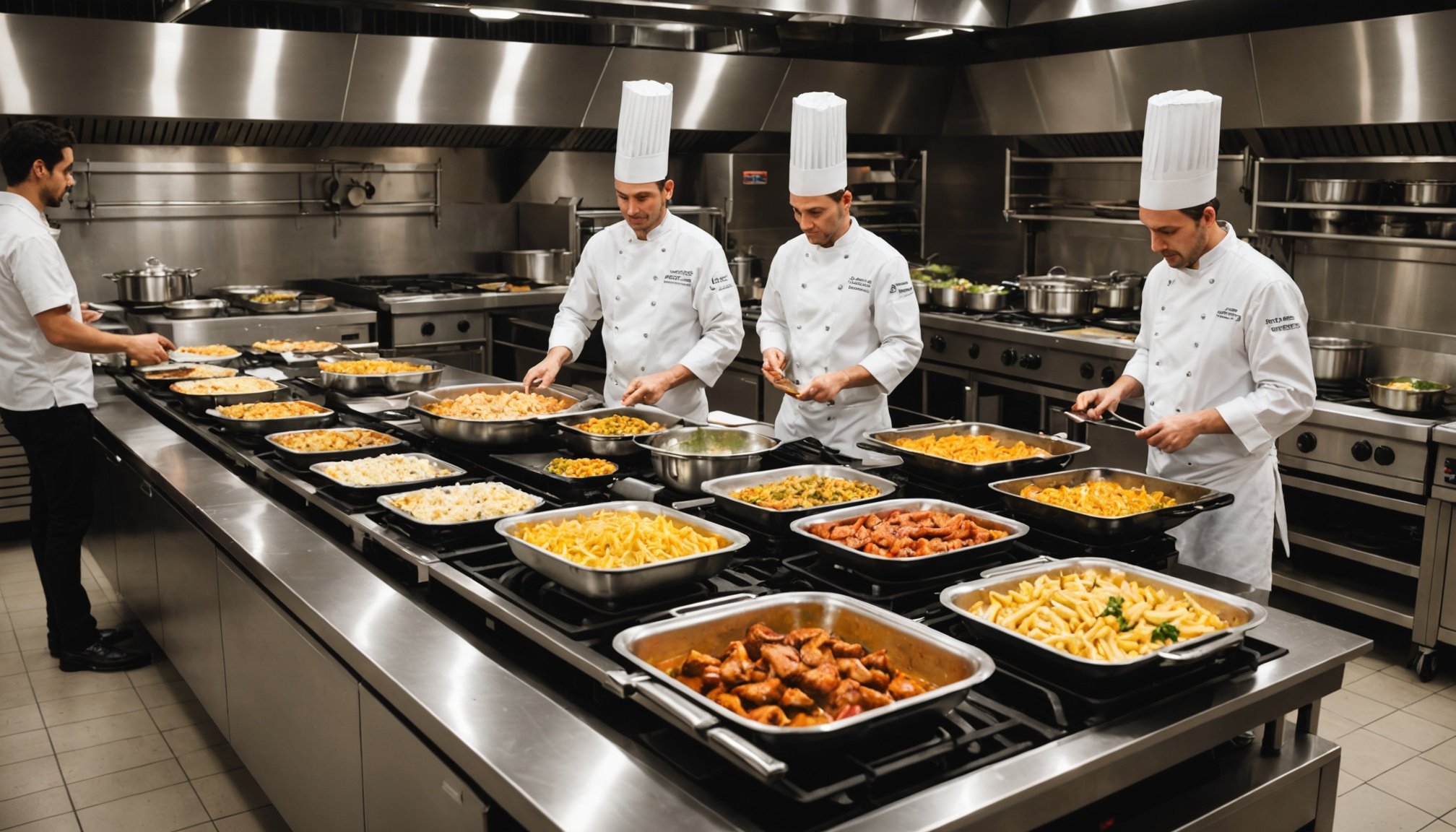Understanding Live Cooking Stations
Live cooking stations are more than just culinary setups; they transform the traditional dining experience by allowing chefs to prepare dishes in front of customers. This interactive approach adds a dynamic element to buffet restaurant concepts, enhancing the sensory experience beyond just taste.
The implementation of live cooking stations provides numerous benefits. Primarily, it increases customer engagement by allowing guests to witness the creation of their meals, which often generates excitement and interest. This engagement is heightened by the aroma and sizzle, elements that are absent in pre-prepared buffet items. The visual spectacle not only attracts diners but also assures them of the freshness and quality of the food being served.
This might interest you : Flavorful Plant-Based Secrets: Masterful Tips to Enhance Vegan Cuisine at Your Restaurant
Customer expectations have evolved with the growing popularity of interactive dining experiences. Guests are no longer content with passive dining; they seek participative engagements that involve them in the culinary process. This shift has prompted buffet restaurants to innovate, thus integrating live cooking stations to meet these demands effectively.
Moreover, live cooking stations provide a platform to showcase culinary artistry, utilizing techniques that are not typically seen in traditional dining environments. By doing so, these stations fulfill the contemporary diner’s desire for both entertainment and high-quality food.
Also to discover : Mastering Ice Cream Freshness: Expert Tips to Prevent Freezer Burn in Your Dessert Oasis
Key Elements of a Successful Live Cooking Station
Operational efficiency in a successful live cooking station begins with the right equipment and setup requirements. This includes ensuring all essential components—such as grills, fryers, and refrigeration units—are readily accessible to chefs. A thoughtful layout enhances efficiency, allowing chefs to pivot seamlessly between tasks.
The importance of layout design for customer flow cannot be overstated. A well-organised station promotes smooth traffic, ensuring diners can comfortably engage without congestion. Thoughtful placement of cooking areas, utensils, and even condiment stations is crucial for maintaining an inviting environment. By optimizing space, you enhance both operational efficiency and guest experience.
Choosing the right cooking techniques serves a dual purpose: ensuring meal quality and maximizing visual appeal. Techniques such as flambé, grilling, or sautéing provide enticing sights and aromas, appealing directly to the senses of onlookers. Chefs should tailor techniques to accentuate the flavours of the dishes while delivering an engaging visual spectacle.
Together, these components blend practicality with dynamic engagement. Focusing on operational efficiency aligns with guest enjoyment and satisfaction, establishing the foundation for a standout dining experience. These seamless processes foster not only functionality but also delight, leaving customers eager for their next meal.
Menu and Culinary Technique Selection
Crafting a captivating culinary journey begins with strategic menu selection. Offering a wide range of dishes caters to diverse tastes and dietary preferences, enhancing customer engagement. Incorporating local and seasonal ingredients not only brings authenticity but also showcases freshness. This approach aligns with contemporary dining preferences, creating a unique connection with the locale.
Choosing innovative culinary techniques can transform ordinary dishes into spectacular visual presentations. Techniques like sous-vide, flambé, and molecular gastronomy can produce engaging recipes. Such methods create a sensory delight that pairs with the interactive nature of live cooking stations, amplifying both visual appeal and taste.
When considering engaging recipes, chefs should focus on weaving creativity with flavour. Combining unexpected ingredients or presenting classic dishes with a modern twist holds diners’ attention and curiosity.
By understanding and aligning with guests’ desires for intriguing dining experiences, establishments can effectively leverage this approach to stand out. Presentation and creative execution are as vital as the ingredients themselves, providing an unforgettable dining affair. This balance not only rejuvenates traditional buffet settings but also positions live cooking stations as a forward-thinking buffet restaurant concept that consumers are eager to explore.
Ensuring Service Efficiency
In the realm of live cooking stations, maintaining service efficiency is pivotal for a fluid and satisfying dining experience. Equipping staff with the right skills through comprehensive staff training enhances both the speed and quality of service. Effective training programs ensure that personnel are adept at multitasking and communicating seamlessly, crucial for managing high-pressure environments typical in bustling buffet restaurant concepts.
The design and implementation of streamlined operational workflows play a significant role in reducing customer wait times. By assigning specific roles and responsibilities, staff can execute tasks with precision, thus ensuring timely meal service. Strategies such as synchronized cooking methods and efficient use of cooking equipment are essential for optimizing time and productivity in these live settings.
Moreover, adopting real-time monitoring systems helps in quickly identifying and addressing bottlenecks, thereby enhancing overall service efficiency. Regular assessments of workflow systems and staff performance can lead to continual improvements, further elevating the dining experience.
These practices not only ensure a swift and enjoyable meal preparation process but also significantly contribute to customer engagement, fostering a dynamic atmosphere where guests remain entertained and satisfied. Emphasizing efficiency is key to sustaining the lively rhythm that patrons expect from live cooking stations.
Enhancing Customer Interaction
Incorporating customer interaction within live cooking stations elevates the dining experience significantly. Chefs can employ various techniques to engage guests as they prepare meals. Inviting diners to ask questions and participate in the cooking process establishes a connection between the chef and the patron, enriching the atmosphere and experience.
Enhancing the dining experience often involves storytelling. Chefs can share tidbits about the cuisine’s history, cultural significance, or personal anecdotes related to the dish being prepared. Stories not only captivate the audience but also create a memorable journey, transforming a meal into an engaging narrative.
Further enhancing interaction involves engaging staff actively. Attentive and engaging staff play a crucial role in curating a lively environment. They can provide insights into menu selections, offer cooking tips, and even recommend wine pairings, all while maintaining a welcoming demeanor.
Finally, collecting customer feedback is vital for continuous improvement. Feedback mechanisms, such as surveys or informal chats, allow establishments to refine their offerings based on guest preferences and enhance the overall experience. When feedback is implemented effectively, it not only meets but exceeds client expectations, setting an interactive dining framework for success.
Case Studies of Successful Live Cooking Stations
Exploring case studies of successful live cooking stations reveals insights into effective strategies and implementations. Notable buffet restaurant concepts often incorporate these stations as a focal point, enhancing the dining experience.
For instance, an acclaimed buffet in Las Vegas transformed its environment by integrating interactive cooking hubs. Here, chefs engage directly with customers, choosing live cooking stations as the platform for showcasing culinary skills and innovation. This approach not only facilitated customer engagement but also elevated the restaurant’s prestige by offering a unique and personalised dining journey.
Key takeaways from such implementations underscore the importance of strategic placement and chef interaction. Successful examples demonstrate that aligning customer expectations with the dining atmosphere fosters a more immersive experience. The strategic use of live cooking stations in these environments has repeatedly proven to attract and retain a diverse clientele.
Buffet restaurants aiming to emulate these results can focus on crafting an environment that harmonizes excitement and efficiency. Insights from these case studies highlight the necessity of blending engaging culinary performances with thoughtful operational practices. This alignment ensures a memorable and enjoyable dining experience, securing customer loyalty and satisfaction.





